Dopiaza curry is an ancient Indian dish that’s become a favourite worldwide. And it’s not surprising. Big, bold tastes of spice and lots of onions make this one seriously tasty curry.
Dopiaza hails from the Hyderabad region of India so it’s a South Indian homestyle curry that’s been adapted to work in restaurants. If you like onions, and you like curry, I think you’ll like a dopiaza curry.
Dopiaza curry gets its roots from Persian cuisine
There’s a bit of a legend around the origins of dopiaza. It was invented by accident when the cook of a Moghul emperor accidentally added way too many onions to a dish. Good thing the emperor liked onions. This could have ended badly for that cook.
The cook’s name was Do Piaza. His name lives on in this dish. Seems unlikely but who am I to question legend. It’s a good story anyway. And it’s a great curry. One that’s been refined over the years.
I like green chilies in my dopiaza curry. Big hunks of green chili. Gives it a little bit of a jalfrezi thing. That’s not so conventional. So if you want to stick to the more conventional version leave them out. Up to you.
Dopiaza means two onions
Dopiaza means two onions in Persian. But it’s not really two onions. It’s onion two ways. Finely diced onion is added at the beginning and pre-fried large pieces of onion are added right at the end.
Doesn’t seem like a big deal but it’s the little things that make dishes great. And there’s really onions three ways in this dish. Curry base is mostly onions as well.
Cooking curries restaurant style
This is a master dopiaza curry recipe. You can make it with pre-cooked chicken, lamb, beef or use paneer, pre-cooked potatoes, mixed vegetables or fried eggplant for vegan options.
Before you start do your prep. That’s important. Make your curry base and have some heated and ready to go. Pre-cook your meat. Measure out your ingredients. Have everything ready. Put on an apron – a bit of splatter is part of the fun.
If you have not read the guide to Indian restaurant technique yet, do it now. It has pictures to help you understand the recipe. There’s a video there too. And a guide to Indian ingredients in that post. Crash course in Indian restaurant cooking.
Dopiaza curry is popular for a reason. It’s just a simple, tasty curry. Not too fancy. Not too many ingredients. Just lets the onions shine through. Try it. Pretty sure you’ll like it.
indian restaurant dopiaza curry
Ingredients
The spice mix
- 2 tsp Indian restaurant spice mix or curry powder - recipe link below
- 1/2 tsp kashmiri chili powder or 1/8 tsp cayenne mixed with 3/8 tsp paprika
- 1 tsp kasoor methi - dried fenugreek leaves
- 1/2 tsp kosher salt
- pinch of coarse black pepper
The curry ingredients
- 3 Tbsp oil
- 1/2 onion coarsely chopped
- 1/2 onion finely diced
- 1 Tbsp garlic/ginger paste - recipe link below
- 1 green chili seeded and minced
- 1 green chili coarsely chopped (optional)
- 1 1/2 Tbsp tomato paste with enough water to dilute to the consistency of pasatta
- 1 Tbsp cilantro stems - finely chopped
- 15 oz curry base - recipe link below
- 1/2 tsp sugar
- 10-12 oz pre-cooked chicken or lamb
Instructions
- Make the spice mix.
- Pre-cook the coarsely chopped onion. Heat your skillet over medium heat. Add 1 Tbsp vegetable oil and fry the onions until the edges just start to turn brown. Remove onions but leave the oil in the pan.
- Dilute the tomato paste with enough water to get to the consistency of passata.
- Heat your frying pan (don't use non-stick) briefly over medium heat. Add the rest of the oil. Use all the oil specified. It's important.
- When the oil starts to shimmer add the finely diced onion and and stir every few seconds until the onion is soft and starts to brown, about 3 minutes. If you are using the optional coarsely chopped green chili add it in after 2 minutes (so it cooks one minute).
- Next comes the garlic ginger paste. Add it into the pan and cook it, stirring constantly, until it stops sputtering.
- Stir in the green chili and minced cilantro stems and stir. Cook for another 15-20 seconds.
- Turn down the heat and add the spice mix. This is the critical step. Stir it constantly for 30 seconds. If it starts to darken lift the pan off the heat. You want the spice mix to cook in the oil but not burn.
- Turn the heat up to medium high. Add the diluted tomato paste and stir until bubbles form (the oil will likely separate). This takes around 30 seconds to one minute depending on the heat.
- Add 3 oz of curry base. Stir until bubbles form (little craters really), around 30 seconds. Watch the edges of the pan. The curry can stick here.
- Now add 6 oz of curry base and stir briefly. Let it cook until the bubbles form again. This takes 1-2 minutes.
- Add the rest of the curry base and let cook until the bubbles form. Turn the heat down to low and add the pre-cooked lamb, beef or chicken, the pre-cooked onions and the sugar.
- Let the curry simmer for about 5 minutes. If it gets too thick add a bit more curry base. Don't add water.
- Garnish with a bit of chopped fresh cilantro and serve.

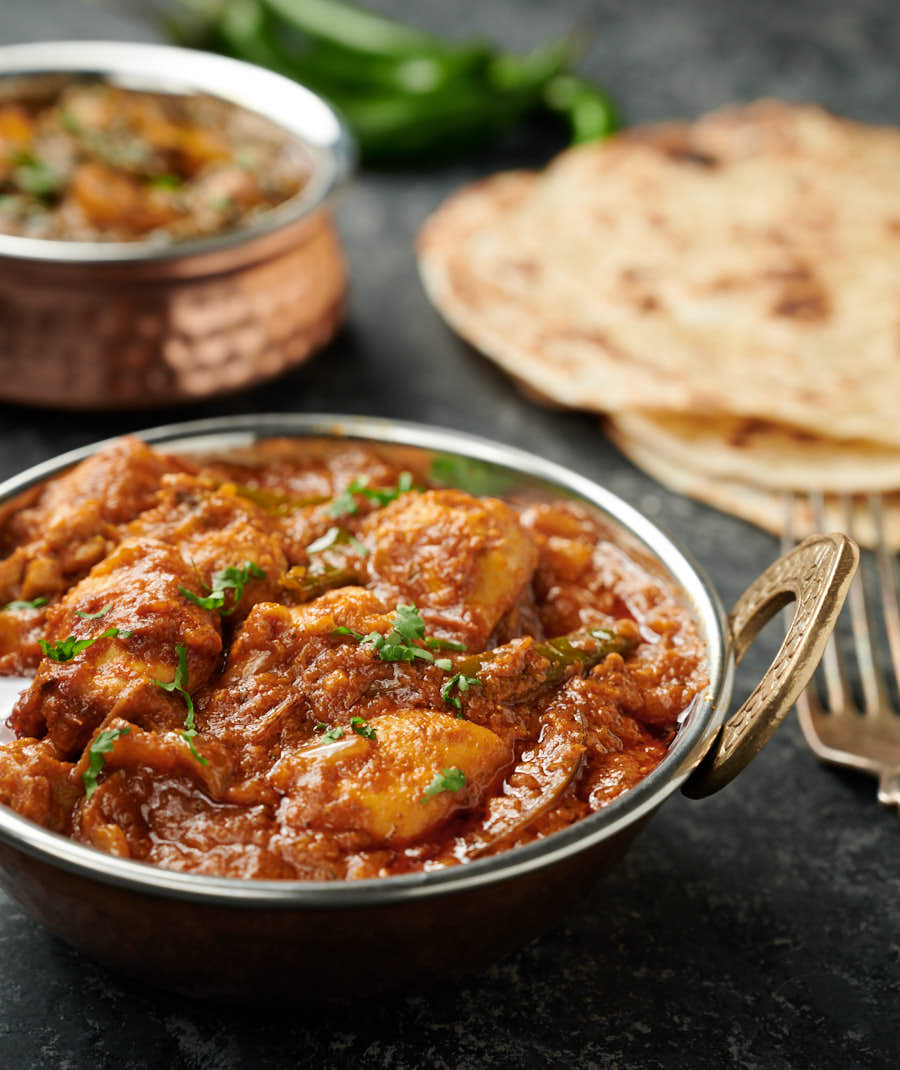
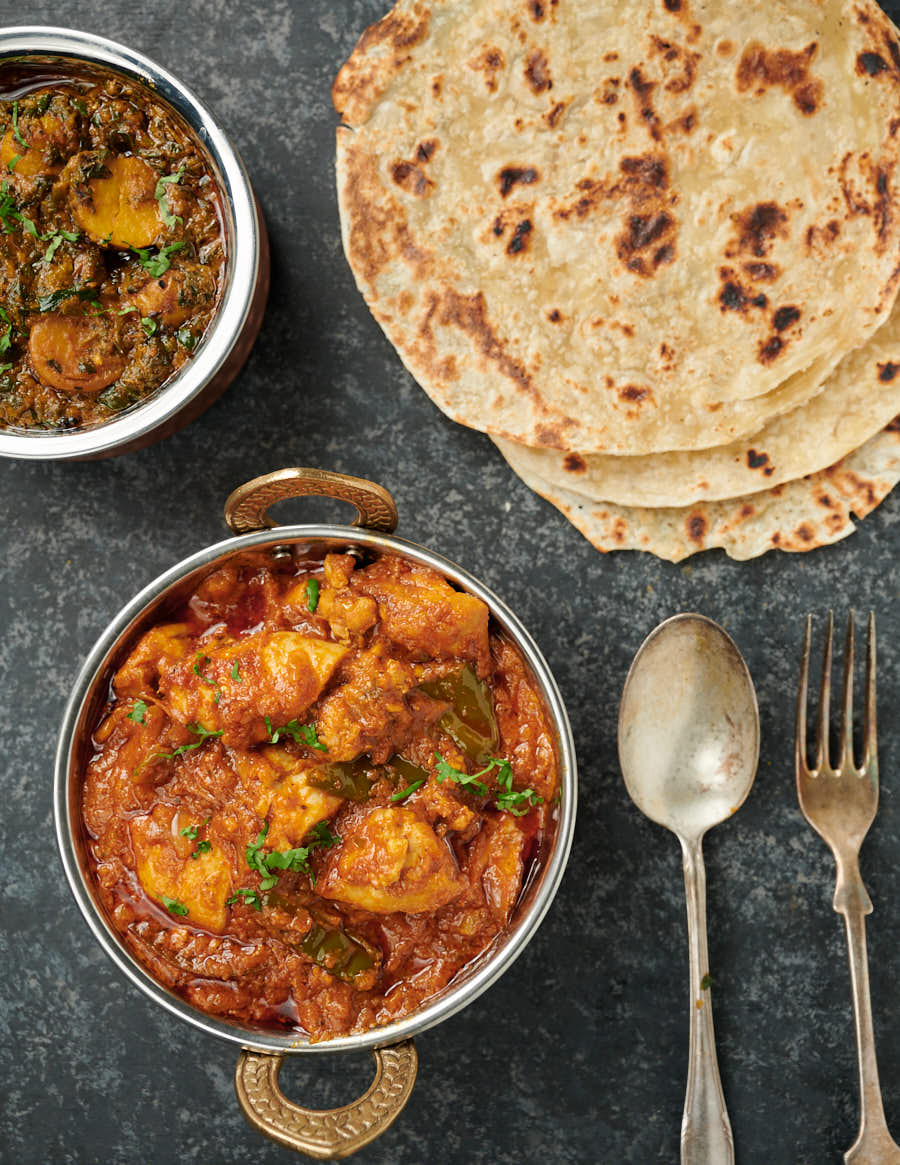
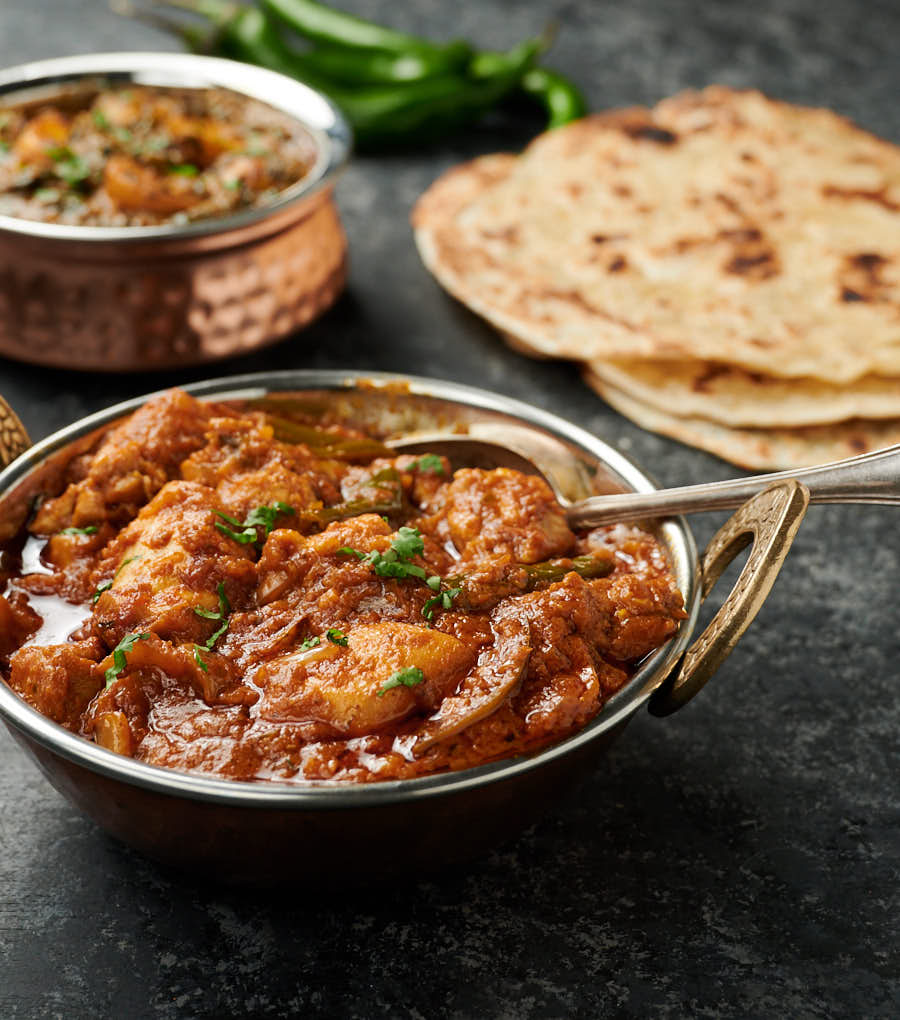
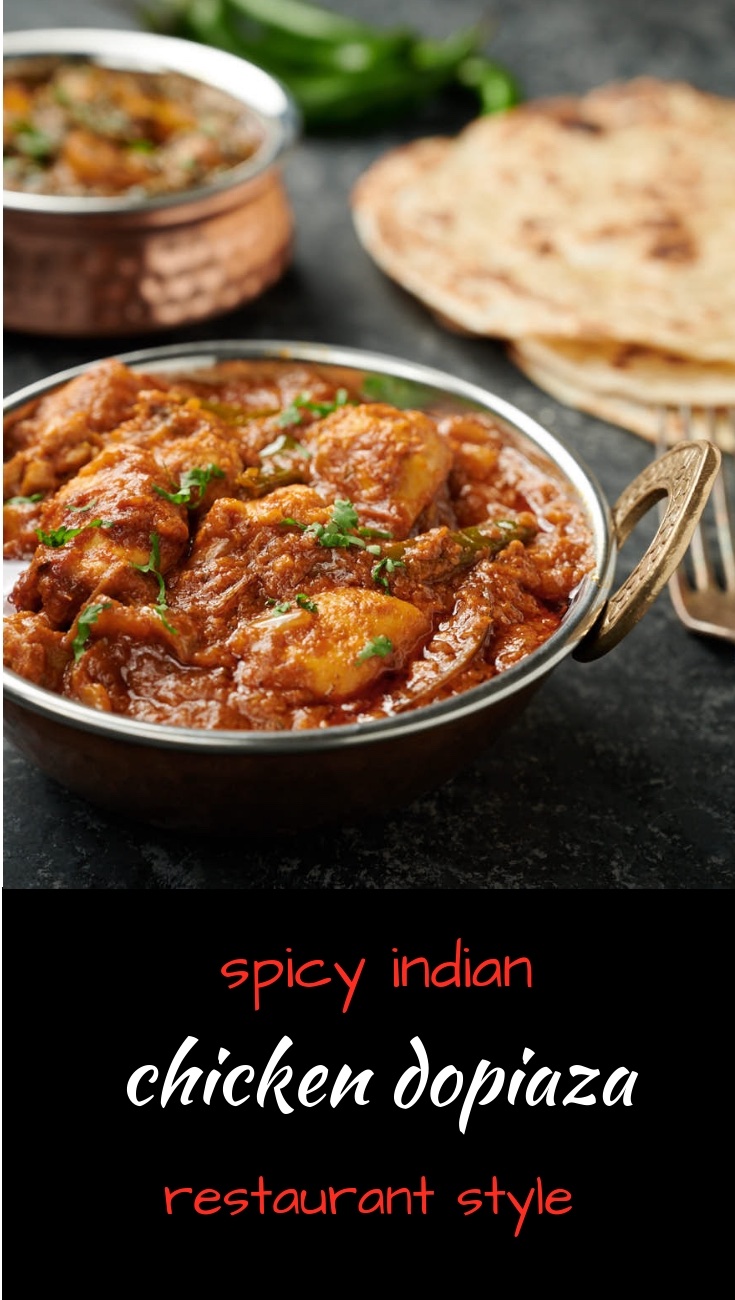
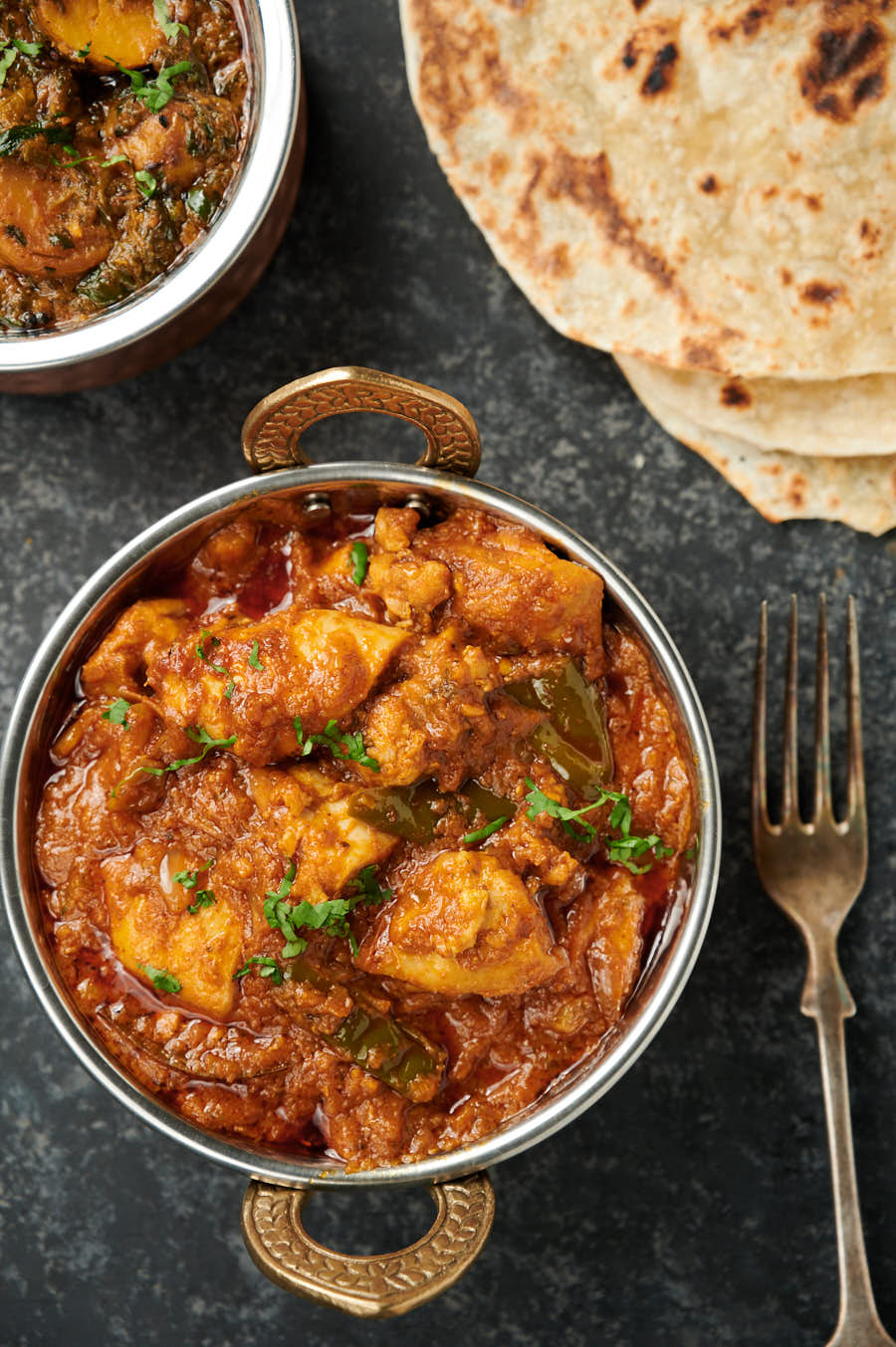
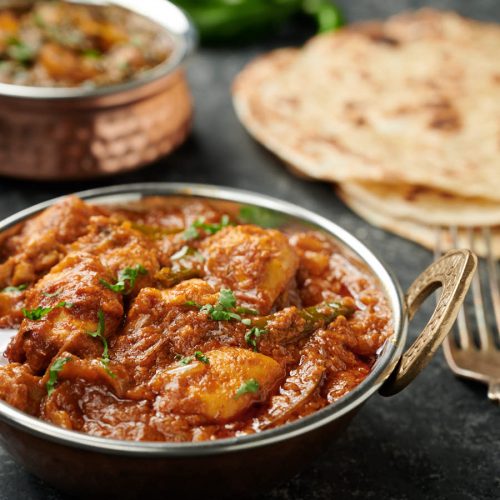
So i made the Dopiaza in 3 stages….its bloomin’ great,went like a dream!Saving it for tomorrow and i will be making Bombay potatoes in 3 batches too. I think my guests will be very impressed.
Thankyou for this.
Thankyou Romain, i was thinking along the same lines, it makes sense. I will cook 3 batches.
Can’t wait to taste it!!
Hope you love it!!!
I am cooking for 6 persons, do i just triple the ingredients?
No, I’m afraid that won’t work. To make Indian restaurant style work you really need to fry the curry base pretty hard. It’s too hard to do that if you triple the recipe. I always recommend making the recipe as many times as you need and transfer each batch to a saucepan. Once you have it all done you just gently warm things through so you don’t overcook the chicken and serve.
Or you could use the hotel style dopiaza. Hotel style does scale perfectly. It’s a different approach but it does make some wonderful curries. https://staging2.glebekitchen.com/chicken-dopiaza-indian-hotel-style/
Hi Romain like a number of people on here I’ve been looking for a while for recipes that get you close to that proper restaurant taste, and yours are the best I’ve found. Thank you so much.
That’s great to hear. Thank you!
This was my first curry to cook. Made the base, the spice mix, then this. Made a few mistakes here and there but it was still amazing to eat. We just ate, quietly and were gobsmacked by the flavours.
What a brilliant website!
Thank you for saying. Sounds like the mistakes were small and results were good! Glad you liked it. Once you get the technique down it’s really quite easy to crank out curries that will rival your local restaurants.
Does the type of onions matter? For this recipe and just in general. I’ve read somewhere online that red onions should be used to cook Indian unless otherwise specified – any substance to that claim at all? I’ve made your curry base with mostly red onions with just one white and one yellow. It was very tasty (even by itself surprisingly, before cooking dishes with it). But it was very dark – kind of like your hotel style gravy.
I was also wondering if you add asafoetida and/or black salt to your dishes?
I use plain every day yellow onions for my curry base and my hotel curry gravy. I sometimes use red onions for traditional curries. I don’t often use asafoetida to the curries on the blog although I sometimes do when cooking traditional Indian for myself. Black salt I like quite a bit. I put some in my chaat masala.
Love my onions (I will admit to eating some raw when chopping them) so naturally love a Dopiaza.
I love onions too although I draw the line at eating white, red or green onions straight up. Yellow cooking onions are a bit much for me.
I’ve been looking for years to find an authentic restaurant tasting curry and I can whole-heartedly say that my search is over. I’ve made some damn-fine curries over the years but nothing has quite hit that restaurant sweet-spot, but this IS IT. Made it the yesterday and it is without doubt one of top-five curries of all time. Thank you so much.
You are very welcome. Thank you for taking the time to say so!
I have to say this is the best Indian meal I’ve prepared and it’s all down to your advice. Once this lockdown is over I am going to host a dinner for all other Indian restaurant lovers. Thank you!
You are very welcome.
I found a jar of dopiaza sauce at Lidl and had it for supper tonight. It knocked Rogan Josh into second place on my “favorite curries” list, so I immediately went surfing for a recipe to recreate it, and ran across this one. It looks like a lot of work, but I’m going to give it a whirl next time we have a craving for curry!
At the risk of being bold I think once you get the restaurant technique down you won’t be buying jars of sauce at Lidl anymore…
I actually started my Indian cookery journey by making my own, homemade, curry because there wasn’t any jarred sauce or pre-packaged Indian food available in my area, and no Indian restaraunts. I very rarely use jarred sauce, as I much prefer to make my own, from scratch.
Going to try this today but for four. Do I just double the ingredients?
I generally cook the recipe twice to double the recipe and keep the first batch warm over very gentle heat while I cook the second batch. It is difficult to get the curry base to fry hard enough if you just double the recipe.
I live in the UK and made this from scratch. I must say it was excellent and all my family enjoyed it. I will be trying many more of your recipes so thank you very much.
You are very welcome. I’m so glad you and your family liked it!
I thought Dopiaza meant “two onions” in Hindi because of the mix of fried and puréed onion.
I’ve read that account as well. The legend of an emperor is more fun though, don’t you think? Wikipedia feels good enough about the legend to leave the story up there anyway.
This amounts to the best dopiaza I have ever created, it is my wife’s favourite and she went bonkers, the taste was sublime and spicy but no overly. I am hosting a curry night next week and every recipe is from Glebe Kitchen
Thank you
You are very welcome Steve. Love that your wife went bonkers!
Please let me know how your curry night goes. I can’t wait to hear.
What is the problem with non-stick cookware? I wonder.
A big part of Indian cooking is the slow caramelization of the onions. That takes time. Nobody wants to wait for a curry in a restaurant. Restaurant style Indian cooking relies on high heat to get that effect. Non-stick inhibits this.
Cooked this tonight. Followed your recipe to the letter.
Superb. Really is the nearest thing I have had to a restaurant dish.
Will now work my way through the rest of your Indian dishes.
That’s great to hear. Hopefully I’ve covered a few of your favorites. If not, let me know and I’ll try to post them soon.
:O I LOVE onions! The more the better I say! There’s something about browning onions that just smells and taste so fantastically umami! …and I’d probably have this with noodles! haha 🙂 I’m such a noodle girl.
This dopiaza recipe is layer upon layer upon layer of onions so I think you’ll like it. Curry with noodles – don’t see why not. I’m going to try that too.
Onions are my favorite and if dopiaza translates to “two onions,” I’m already a fan! Your curry recipes all sound amazing and I can’t wait to try this one, thank you for all the amazing tips, tricks and instructions. Pinning for later!
Hope this one lives up to expectations. It is big on onions for sure. It’s really three onions because the curry base is mostly onions as well.